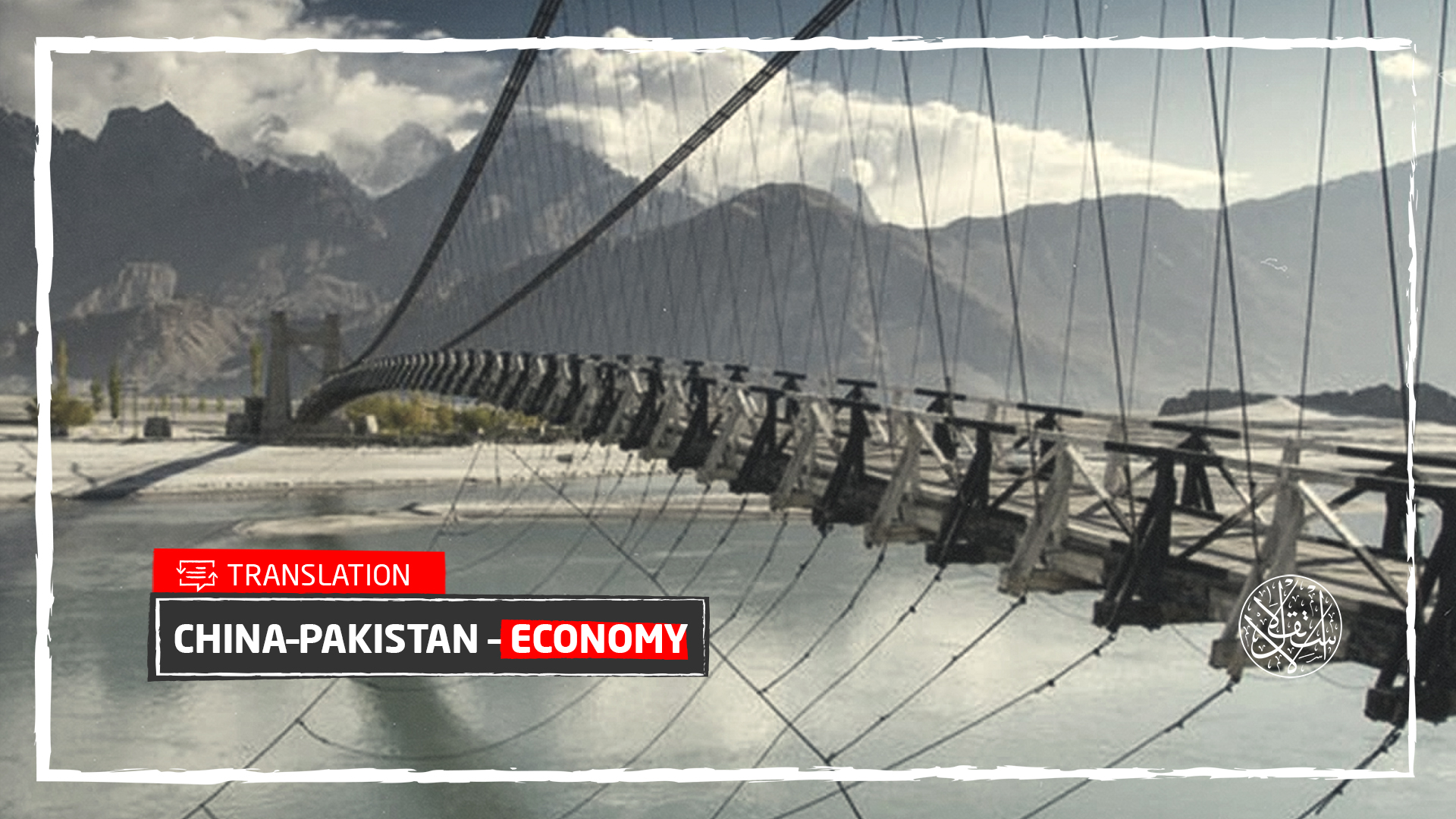Reasons Why the Economic Corridor Between China and Pakistan is a Prominent Step

A Turkish research center deems the China-Pakistan Economic Corridor project as the most important step in the Belt and Road Initiative launched in 2014 with the aim of reviving the historic Silk Road.
This includes the development of road and rail networks in Southeast Asia, South Asia and Europe, and the connection of a sea route network extending to the Middle East and Africa, which was announced by Chinese President Xi Jinping earlier.
"The implementation of the China-Pakistan Economic Corridor (CPEC) has commenced as a large-scale project covering energy, infrastructure and communications systems," explains the Center for Human and Social Research (INSAMER).
Here, Pakistan emerges as one of the main actors in the Belt and Road Initiative, as it is China's oldest strategic and defense partner, as well as being located on a vital point in the Eurasia region, according to Turkish researcher Abdul Wahed Bari.
With an initial investment budget of $46 billion, the project aims primarily to develop and strengthen the current transportation infrastructure and energy sector in Pakistan, in preparation for solving the chronic energy problem and providing the resources necessary to meet the country's current and future energy needs.
It is expected to start establishing special economic zones after the completion of energy and infrastructure projects, according to the author.
He added: It is also planned to link the strategically important city of Kashgar in the Chinese province of Xinjiang with the port of Gwadar in the Pakistani province of Baluchistan through the China-Pakistan Economic Corridor, thus ensuring the uninterrupted movement of products and services between China and Pakistan.
Easier Access
Given the proximity of Gwadar to the Arabian Sea, this route will facilitate China's access to the Middle East.
Energy sector: Pakistan's investments in this field constitute the most important pillars of the Pakistan Economic Corridor project.
A total of $33 billion (about 72 percent) of the $46 billion investment was allocated to sectors related to the development of energy resources (such as the production of gas and electricity from natural resources such as coal).
Which indicates that the China-Pakistan Economic Corridor aims above all to fill the shortage in the energy sector in Pakistan.
Transportation Infrastructure: The development of transportation networks is the second important pillar of the project.
The project plans to invest $11 billion in strengthening Pakistan's transportation infrastructure, including road and rail networks.
Gwadar Port: It is one of the most important pillars of both the project and the Belt and Road Initiative, especially as it will provide an important industrial base for Pakistan.
The port will serve as a base that facilitates the export of Chinese goods and the import of oil and gas to and from the Middle East and Africa in a short time.
Special Economic Zones: are planned to be established within the framework of the project by implementing market-oriented policies to facilitate commercial activities and open the door for local and international investors to invest in the zone, by providing facilities such as energy, infrastructure and tax incentives.
Fiber Optic Communications: are also planned in the project to increase investments for its development.
Here, Huawei, a Chinese multinational, extended an 820 km (510 mi) fiber-optic line from Kashgar to Islamabad with an investment of $44 million in January 2019.
The project aims to create "smart cities" and create advanced monitoring and data collection capabilities.
Pakistan’s Gains
The researcher emphasized China's investments in Pakistan within the framework of the Belt and Road Initiative can be explained from the perspectives of liberalism and realism.
When evaluated from a liberal perspective, this project can be considered as a new step in China's development of its cooperation with Pakistan, one of the important countries in its trade activities.
When looking at a realistic perspective, it can be evaluated in the context of China's efforts to achieve its economic and geostrategic interests by exploiting the rift in the Pakistani-American relations.
It should be highlighted that it is very likely that the United States will develop its relations with Pakistan with similar motives.
Barry points out that the China-Pakistan Economic Corridor project can provide Pakistan with real gains and opportunities, even if it causes some challenges.
Although less than 10 years have passed since its establishment, Pakistan is already seeing the positive effects of the project and significant progress has been made in the country.
"At the start of the project, conditions were difficult for the industrialists in Pakistan," he explained. It was not possible to keep investors in the country due to electricity failures, let alone attract new ones.

However, with the completion of the power generation projects that were implemented as the first step within the scope of the Economic Corridor project, the energy problems ended, which increased the country's attractiveness to investors.
He added: The projects that will be implemented within the scope of the China-Pakistan Economic Corridor, which will ensure economic development in Balochistan in particular, are expected to bring the region, which has retreated from the separatist rebellions, closer to the national mainstream.
On the other hand, the recently signed agreements and memoranda of understanding on cooperation in agriculture under the project will increase agricultural production through the transfer of seeds, modern technologies and new irrigation opportunities to Pakistan, according to the author.
He noted, "Thanks to the cyber infrastructure that was built in the country within the framework of the project, it is planned to lay the foundations for fourth-generation industries such as robotics and artificial intelligence."
In short, the China-Pakistan Economic Corridor is emerging as a project that will contribute to solving infrastructure problems and developing the country socially and economically.
Geostrategic Repercussions
Barry explains that although the China-Pakistan Economic Corridor appears at first glance as a project focused on transportation and infrastructure, it also has important geopolitical and geostrategic goals.
He elucidated: During the presidency of Barack Obama, the United States announced its policy that prioritizes Asia and the Pacific as a countermeasure to China's integration of its economy with that of its allies in the Asia-Pacific region.
It later signed the Trans-Pacific Partnership (TPP).
But with Donald Trump assuming the presidency, Washington has declared that the TPP is detrimental to the country's national interests.
The isolation policies pursued by the Trump administration towards China encouraged Beijing to accelerate its efforts to lead global politics.
However, on the other hand, India - one of the most important countries in the region - has expressed its disapproval of the Belt and Road projects and the China-Pakistan Economic Corridor since its inception, and it still directs various criticisms towards these projects.
Claiming that the Belt and Road Initiative has secret objectives, the Indian government says that a mechanism must be established to ensure transparency in the implementation of these projects.
The most important problem mentioned by India is that the governments of the countries in which projects related to the Belt and Road Initiative are implemented, led by China, do not participate in the decision-making process and that Beijing does not pay attention to the criticisms of these countries, which means that these countries are forced to participate in the project as an obedient country without expressing any objection.
The Indian government also claims that the corridor runs through Jammu and Kashmir — a disputed region administered by Pakistan, but which India claims as its own territory — the researcher says.
He added: It is believed that the border disputes between China and India in the Himalayas in the summer of 2020 erupted due to Beijing's reaction to New Delhi's decision to unilaterally change the status of Jammu and Kashmir.
The objection of the Beijing administration was not enough for India to back down. The writer believes that India's refusal to participate in the Belt and Road Initiative and its hostile stance may push China to pursue a more aggressive policy in the border region of Ladakh in the coming period.
Especially since it is estimated that this tension, which has escalated after 50 years, could lead to dire consequences.
Barry concludes his article by pointing out the increase in military cooperation between the two countries after the China-Pakistan Economic Corridor Agreement.
The joint exercises between the two countries were repeated, especially after the latest developments in Kashmir, and the Pakistani military communication system, including the Global Positioning System (GPS), was linked to the Chinese satellite system.












